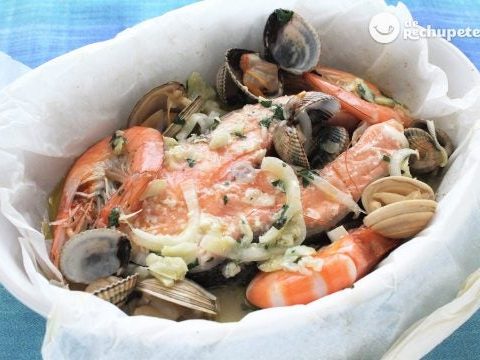
Info.
- Half
- 240 minutes
- For 10 people
- 3.5 € / person
- 198kcal per 100g.
How to prepare canned tuna from the north .
You know I love preserves, I use them in many fish recipes .
I’m even passionate about a simple sardine sandwich with tomato slices, one of my little gourmet delights.
If I start a meal with a northern tuna salad, I assure you that nothing can spoil it anymore.
In my kitchen you can see that there is a little of everything: big asparagus, anchovies, piquillo peppers, tuna belly … but clearly the latter is my favorite preserve.
It is not cheap, but the quality of the product is worth what it costs, although there is a cheaper alternative is to make them at home .
In less than 4 hours you can have jars of bonito from the north preserved throughout the year, not only for your own consumption, but also to make gourmet gifts made by yourself from the ciborium.
The tuna from the north “dull” is usually prepared now in autumn when it is cheaper, you can buy a whole one almost half the price than in high season.
Of course my advice is to be Galician, from Burela, you know that I always go shooting for the land.
Be sure to try the sweet texture of your homemade canned tuna from the north.
Bonito nutritional values and uses in the kitchen
Bonito is one of the staples of the Mediterranean diet. When Northern tuna is consumed, we are taking a healthy and wholesome food, rich in both proteins and vitamins A, B, D, and K. It provides minerals such as calcium and iodine, essential for metabolism.
Its high nutritional properties stand out, as it is rich in linoleic acid and Omega 3.
In the kitchen its versatility is enormous: it is ideal for preparing skewers, toasts, skewers and tapas, and it is the main ingredient in starters such as salads, vegetable stir-fries, tortillas, pasta and rice dishes.
It is also perfect in the preparation of unique dishes, from delicious fillings to traditional stews such as bonito with tomato or Basque Marmitako.
Choice and purchase of bonito from the North
For the preparation of canned Bonito del Norte we must adjust to its fishing season, from June to October.
From mid-August the specimens are more tasty. We will ask the fishmonger for a good White Tuna, with designation of origin, either from Burela (Lugo) or from the Bay of Biscay. The weight will depend on the amount of canning that we want to make.
In the Rubén workshop he used a nice 8 kg, of which we lose 20% (1.5 kg) in the cut and ½ kg more in the cleaning of skin and thorns. Therefore we have 6 kg usable, we will get 2 cans of belly and about 25 cans of the rest (measures for medium boats 8 cm high).
In the cut or snoring we must ask the fishmonger to separate the belly and then sections of about 8-10 cm, which are in proportion to the height of our boats.
The first cut will contain the neck, which is the juiciest part of the Bonito, which you can reserve for a Bonito stew , a good Marmitako or a Bonito with tomato . The rest of the cuts are kept in the refrigerator until you go to make the preserves.
Elaboration of artisan canning
Cooking
- Heat water in a large pot with 3-4 large carrots, 2 large onions (cut into quarters), an unpeeled head of garlic and some bay leaves.
- As soon as it starts to boil, add the pieces of bonito (except the belly), and when the boil returns, leave about 20 minutes of cooking.
- The proportion of salt is 100 g for each liter of water. Although it seems a lot of salt, remember that it is an 8 kg piece and that the slices are very fat, so for cooking we need a very large casserole, a type to make broth, the one you can see in the photos is 10 liters, with which we have added 1 kg of salt. I assure you that it is perfect salt point.
- When we observe that the white thorn begins to separate from the meat, we remove and reserve to cool, normally about 30 min.
- Now we repeat the process with the belly but with a 10-minute cook.
Cleaning and selection
- Once cold or warm (the important thing is to be able to handle it without burning), we proceed carefully to remove the skin and any scale that may have remained.
- We separate the meat from the central bone, remaining in quarters.
- Now we proceed to separate the white part of the meat from the darker one, with the help of a knife.
- The central areas are the darkest, and we reserve them for later use.
Placement
- We assume that the jars and their lids have been sterilized in boiling water for at least 30 minutes or that we have washed them in the dishwasher.
- The selected white parts are introduced into the cans so that regular and wide pieces are outward (visible part). Filling the central part with more irregular pieces.
- With the help of a knife we are compacting the bonito so that there is no air between the pieces.
- The bonito meat must fill up to the neck of the pot, where the thread begins.
Filled with extra virgin olive oil
- We will use an extra virgin olive oil but not very strong, Arbequina type is enough, but it is of quality.
- We proceed to fill the cans with extra virgin olive oil until the beginning of the neck of the pot, leaving it flush with the bonito, barely exceeding 1-2 mm.
- They will have to rest between 10 and 12 hours, so that the bonito will absorb oil.
- We check the oil level in the pot and fill flush if necessary. For example, if it is done in the afternoon we would leave it resting until the next morning. If we want to shorten the times, we fill less initially.
Covered and preserved
- We put the covers to cook in water and when the first bubbles begin, remove.
- Hot, we cover the cans with their corresponding lid. We place the closed jars in a large pot with water, which overflows about 5 cm to the jars.
- We make a first layer, place a rag and put a second layer of cans, ensuring that the water is always above the cans.
- We cook in a bain-marie for a minimum of 1 h 30 min. At the end of that time the fire goes out and we let them cool in that container. (During this process, a boat may lose oil, it is normal nothing happens).
- Once cold, we dry and store our boats in a clean, dry place where the light does not give it much light.
- First we will place them inverted (with the lid down) to promote sealing and in about a week. we turn them around.
- To obtain its optimum consumption point, we must respect at least 3 months of rest.
- These preserves are perfectly sterilized and closed, so they will last a whole year or even longer.
Perfect preserves for the whole year, cold or hot.
With them you can prepare thousands of recipes, from a simple salad, some toasts … to an appetizer like the one Rubén prepared for us, accompanied by some piquillo peppers and natural tomato.
Your tips for canned tuna
As in all recipes, I will complete the recipe depending on your contributions or questions, Isabel Camden has sent me an email that I think you should include to resolve any doubts:
“You comment that they put the jars already closed and with water that covers only a little, that we put a rag on them and another layer of jars, my question would be this … if they only have to be filled a little above their lid, When we put another layer of jars on top, we have to put more water so that those who are above will also get the water to the edge, then those below will completely cover themselves with water … if we want those who are above to reach them Water. What I did was put just one batch of jars and nothing on top of them, so as not to have to exceed the water level too much, then I put in another batch and so on until I finish. Can you clarify it for me please, if I have not understood it correctly, but I already say two layers of jars one on top of the other … the ones below completely cover themselves with water, apart from that it has to be a super deep pot, to let two layers go on top of each other. ”
Rubén has helped me, explaining this step a little more: “The fact of carrying out the two rows of jars is just to save time, since the cans must be an hour and a half to the bain-marie. If you prefer they do it one at a time, but the important thing is that the water covers the boats. It is recommended that it is at least 4-5 cm above the top of the cans to make it easier to heat the water and not waste it. Putting a cloth rag at the base of each layer of boats is important, so that they settle and do not collide with each other. Otherwise they may explode. ”
And Carmen Domene tells me by email; “ I have been making canned bonito for 10 years, and although the preparation is very similar, I put less amount of water when cooking, like half the cans, and cook them in a water bath in the pressure cooker . I also use the rag so that the boats don’t hit each other. ”
Be sure to enjoy all the recipes for fish and seafood that we have on the blog.






